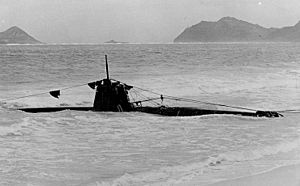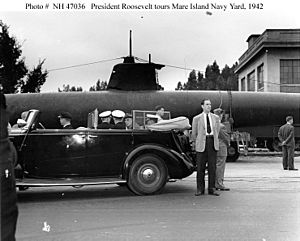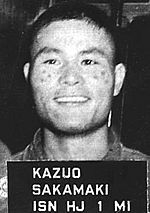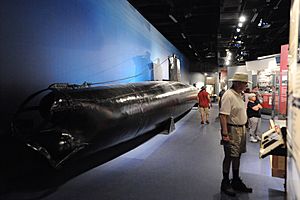HA. 19 (Japanese midget submarine) facts for kids

HA. 19 grounded in the surf on Oahu after the attack on Pearl Harbor, December 1941
|
|
Quick facts for kids History |
|
|---|---|
| Name | HA. 19 |
| Builder | Kure Naval Dockyard, Kure |
| Launched | 1938 |
| Captured | Grounded, Oahu 7 December 1941 |
| Status | Museum Exhibit |
| General characteristics | |
| Type | Type A Kō-hyōteki-class submarine |
| Displacement | 46 long tons (47 t) submerged |
| Length | 23.9 m (78 ft 5 in) |
| Beam | 1.8 m (5 ft 11 in) |
| Height | 3 m (9 ft 10 in) |
| Propulsion |
|
| Speed |
|
| Range |
|
| Test depth | 30 m (98 ft) |
| Complement | 2 |
| Armament |
|
|
HA. 19 (Japanese Midget Submarine)
|
|
| Location | National Museum of the Pacific War, 340 E. Main St., Fredericksburg, Texas |
| Area | 0.1 acres (0.040 ha) |
| NRHP reference No. | 89001428 |
| Significant dates | |
| Added to NRHP | June 30, 1989 |
| Designated NHL | June 30, 1989 |
The HA. 19 was a special type of small submarine called a midget submarine. It was part of the Imperial Japanese Navy during World War II. This submarine played a role in the Japanese attack on Pearl Harbor on December 7, 1941.
The crew of HA. 19 had a mission to enter Pearl Harbor in Hawaii. They were supposed to attack American warships using its two torpedoes. After the attack, they were ordered to sink the submarine themselves using explosives, a process called scuttling. However, the crew faced problems finding their way into the harbor. The submarine ended up getting stuck and was later captured by American forces.
Today, HA. 19 is on display at the National Museum of the Pacific War in Fredericksburg, Texas. It serves as a reminder of the events of World War II.
Contents
Building the HA. 19 Submarine
HA. 19 was built in 1938 in Kure, Hiroshima, Japan. It was made at the Kure Naval Arsenal, which was a major shipyard. This submarine belonged to a group known as the Type A Kō-hyōteki-class midget submarines. These were very small submarines designed for specific missions. Later, in May 1941, a special periscope (a device to see above water) was added to the submarine.
The Attack on Pearl Harbor
In November 1941, HA. 19 was part of a Japanese naval group called the Kido Butai. It was carried by a larger submarine, the I-24, which acted as its mother ship. The two-person crew of HA. 19 included Ensign Kazuo Sakamaki and Chief Warrant Officer Kiyoshi Inagaki.
Launch and Early Problems
On December 7, 1941, at 3:30 AM, HA. 19 was launched from I-24. Right away, the submarine had a problem: its gyrocompass was broken. A gyrocompass helps a ship navigate and stay on course. The crew had about four and a half hours to reach Pearl Harbor. They tried to fix the compass while they were on their way.
Trouble at the Harbor Entrance
As HA. 19 got close to the entrance of Pearl Harbor, the broken compass caused more trouble. The submarine hit a coral reef three times. At 8:00 AM, it got stuck on the right side of the entrance.
The main attack on Pearl Harbor was already happening. At 8:17 AM, the stranded submarine was seen by the American destroyer USS Helm. Inagaki quickly made the submarine dive underwater. When it came back up at 8:19 AM, the destroyer saw it again and fired its guns. The shots missed but the force of the blast pushed HA. 19 off the reef. This impact knocked Sakamaki unconscious. Inagaki quickly dived the submarine again to escape.
Final Attempts and Abandonment
When Sakamaki woke up, the crew tried again to enter the harbor. The earlier grounding had damaged the submarine, so one of its torpedoes could not be fired. HA. 19 was also slowly filling with water. The batteries were touching the seawater, which caused dangerous fumes.
They tried to enter the harbor again but hit the reef once more. They backed up and tried a different approach. On the next try, it got stuck again but managed to get free by adjusting its ballast (weight used to control diving and surfacing). On their last attempt, HA. 19 was hit by depth charges. These are underwater bombs that disabled the other torpedo and damaged the periscope.
The crew decided to give up on the attack and return to their mother ship, I-24, near Lanai. However, the fumes from the damaged batteries made them pass out. When they woke up, it was night. They planned to steer the submarine onto the beach at Waimānalo. But the engine stopped, and the submarine got stuck on an offshore reef. Sakamaki told Inagaki to leave the submarine while he set the explosive charge to sink it. The charge did not go off, probably because it was wet. Sakamaki managed to swim to shore and was captured the next day. Sadly, Inagaki drowned, and his body was found on the beach the following day.
Capture of HA. 19
The American forces gave HA. 19 the name "Midget C." This was because it was the third midget submarine they had seen. On December 8, 1941, the abandoned HA. 19 was bombed by U.S. Army aircraft. The bombs missed, but the submarine broke free and washed onto the beach.
In the days after the attack, HA. 19 was pulled out of the sea using an Army tractor. This submarine was designed to be taken apart into three sections. This feature was used to dismantle it carefully without destroying it. It was then taken to the Naval Submarine Base Pearl Harbor. There, experts studied it to gather technical information and documents. They found that most of the damage to HA. 19 was from hitting the reef multiple times.
HA. 19 as a Museum Exhibit

In September 1942, HA. 19 was sent to the U.S. mainland. It went on tours to help sell war bonds. These bonds were a way for people to lend money to the government to help pay for the war. The submarine was at Navy Pier in Chicago, Illinois, when World War II ended.
On January 20, 1947, HA. 19 was put on display outdoors at Naval Station Key West in Key West, Florida. Later, on December 2, 1964, it was loaned to a local historical group. They moved it to an outdoor exhibit next to the Key West Lighthouse. On June 30, 1989, HA. 19 was officially recognized as a U.S. National Historic Landmark. This means it is a very important historical site.
In 1990, the Key West museum decided to focus only on the lighthouse. They started to get rid of their military items. So, in 1991, HA. 19 was moved to Fredericksburg, Texas. It became part of the National Museum of the Pacific War. That same year, Kazuo Sakamaki, the submarine's former crew member, visited the museum. He was reunited with the submarine he had commanded decades earlier.







